A familiar narrative of recent American history runs like this: The modern conservative movement started bubbling in the 1930s and 1940s, in opposition to Franklin D. Roosevelt’s New Deal. Then, in 1964, “The Movement” started really roaring, when Barry Goldwater, a fervent opponent of the New Deal, won the Republican presidential nomination. Goldwater lost in a landslide that year, and yet even in defeat, he laid the seeds for the future victories of his logical successor, Ronald Reagan. Reagan won the governorship of California in 1966, amidst the national backlash against Lyndon Johnson’s Great Society liberalism, and then, in 1980, he won the White House, thus finally redeeming Goldwater’s anti-New Deal vision.
This narrative shapes much of Republican thinking to this day. In domestic policy, Republicans, styling themselves as latter-day Reaganites, tend to judge their “purity” based on their opposition to such pillars of the New Deal as Social Security, even as they pursue post-Reagan agenda items such as the flat tax and school vouchers. Meanwhile, in foreign policy, Reagan wannabes have gone hunting overseas for new “evil empires” to bring down.
These crusaders might admit that ideas such as Social Security privatization and Iraq-style regime-change are distinctly unpopular, and yet, this thinking continues, if they are in the tradition of the Gipper, they must be good. And so Republicans should keep pushing them, they insist, in the prayerful hope for some ultimate rendezvous with Reagan. After all, what Republican would want to break faith with the 40th president, the last truly popular two-term GOP chief executive?
Yet now comes author Henry Olsen with another interpretation of Reagan’s life and work. He argues that the familiar narrative is, in fact, wrong, that it badly misreads the real Reagan. In his new book, The Working Class Republican: Ronald Reagan and the Return of Blue-Collar Conservatism, Olsen, a fellow at the conservative Ethics and Public Policy Center in Washington, DC—a group founded by a man, Ernest Lefever, whom President Reagan would later nominate for a top job at the State Department—argues that Republicans today are getting the Reagan record wrong. In misremembering Reagan’s life, they misapprehend Reagan’s legacy.
 During his career, Olsen asserts, Reagan was an enemy of LBJ’s Great Society, but not of FDR’s New Deal. Yes, there’s a big difference between the two eras, one in the 30s and the other in the 60s. And if today’s conservatives choose to conflate the two, and attack both, well, they not only do an injustice to Reagan’s memory, they also do great harm to their own careers. And why is this? Because, as Olsen documents, the fundamentals of the New Deal are still quite popular, even if their specific details have been silted over by the sediments of seven decades.
During his career, Olsen asserts, Reagan was an enemy of LBJ’s Great Society, but not of FDR’s New Deal. Yes, there’s a big difference between the two eras, one in the 30s and the other in the 60s. And if today’s conservatives choose to conflate the two, and attack both, well, they not only do an injustice to Reagan’s memory, they also do great harm to their own careers. And why is this? Because, as Olsen documents, the fundamentals of the New Deal are still quite popular, even if their specific details have been silted over by the sediments of seven decades.
Moreover, today, it’s the political left, while revering FDR in the abstract, that has been ignoring Roosevelt’s principles. That is, there’s nothing in the Roosevelt record that justifies cutting American strength, opening America’s borders, or mandating co-ed bathrooms.
Thus, Olsen declares, if Republicans were smart enough to pick up the true Reagan torch—embracing the essentials of the New Deal while rejecting the excesses of the Great Society—they would be much stronger politically.
Olsen describes his own background as that of a hardcore Republican growing up in then-Governor Reagan’s California. Indeed, in his admiration for Reagan, he set out to write a book in keeping with the familiar conservative narrative. It was only when he started actually digging into the Reagan archives that he found shocking counter-indicators: That is, maybe the conventional wisdom wasn’t so wise.
As he puts it, “Everything I had been told about Reagan’s philosophy, by the Right and the Left, had been wrong.” Thus the direction of his book would have to change; his new mission was to “revise what most people think about Reagan.”
Olsen writes:
He did not attack laws that favored labor unions in bargaining. He did not argue against the building of roads, the implicit subsidy of suburban housing programs provided by the FHA and the GI Bill, or the massive expansion of public universities pushed by the New Deal devotees in the states. He never attacked the legitimacy or constitutionality of Social Security.
To be sure, not everyone will agree with Olsen’s interpretation. After all, especially in Washington, DC, there’s a huge industry of think-tankers and pamphleteers relentlessly seeking to redefine Reagan as the champion of one or another ivory-tower ideologue. And yet through careful research and deft juxtapositions, Olsen makes a convincing case that Reagan was a “working class Republican,” an avatar of “New Deal conservatism.”
The historical Ronald Wilson Reagan, born in 1911, was the son of a working-class Irish Catholic Democrat. Thus it’s little surprise that the young Reagan would cast his first presidential vote for FDR, a Democrat, in 1932—and his second, in 1936, and his third and fourth in ’40 and ’44.
Still, as Olsen documents, Reagan was never any sort of leftist zealot; even in those radicalizing times, his steadfast Christian faith alone would have kept him from ever even considering some secular “ism,” such as communism. Instead, Reagan was an instinctive centrist—although, of course, in the wake of the Depression, the American center had shifted to the left.
Notably, also, Reagan demonstrated an early knack for politics. In 1947, he was elected president of the Screen Actors Guild (SAG), now an AFL-CIO affiliate, where he served for five years, and again for a briefer stint in the late 50s and early 60s. Reagan thus stands as the only American president to have been the head of a labor union.
The late 40s, of course, were a tumultuous time in Hollywood. As the Cold War chilled, the movie industry came under the inquisitorial microscope of Congressional investigators looking for communists—of whom there were more than a few.
In 1947, on behalf of SAG, Reagan testified before the House Un-American Activities Committee and walked a fine line: He denounced any communist presence, and yet defended Hollywood overall: “I happen to be very proud of the industry in which I work.”
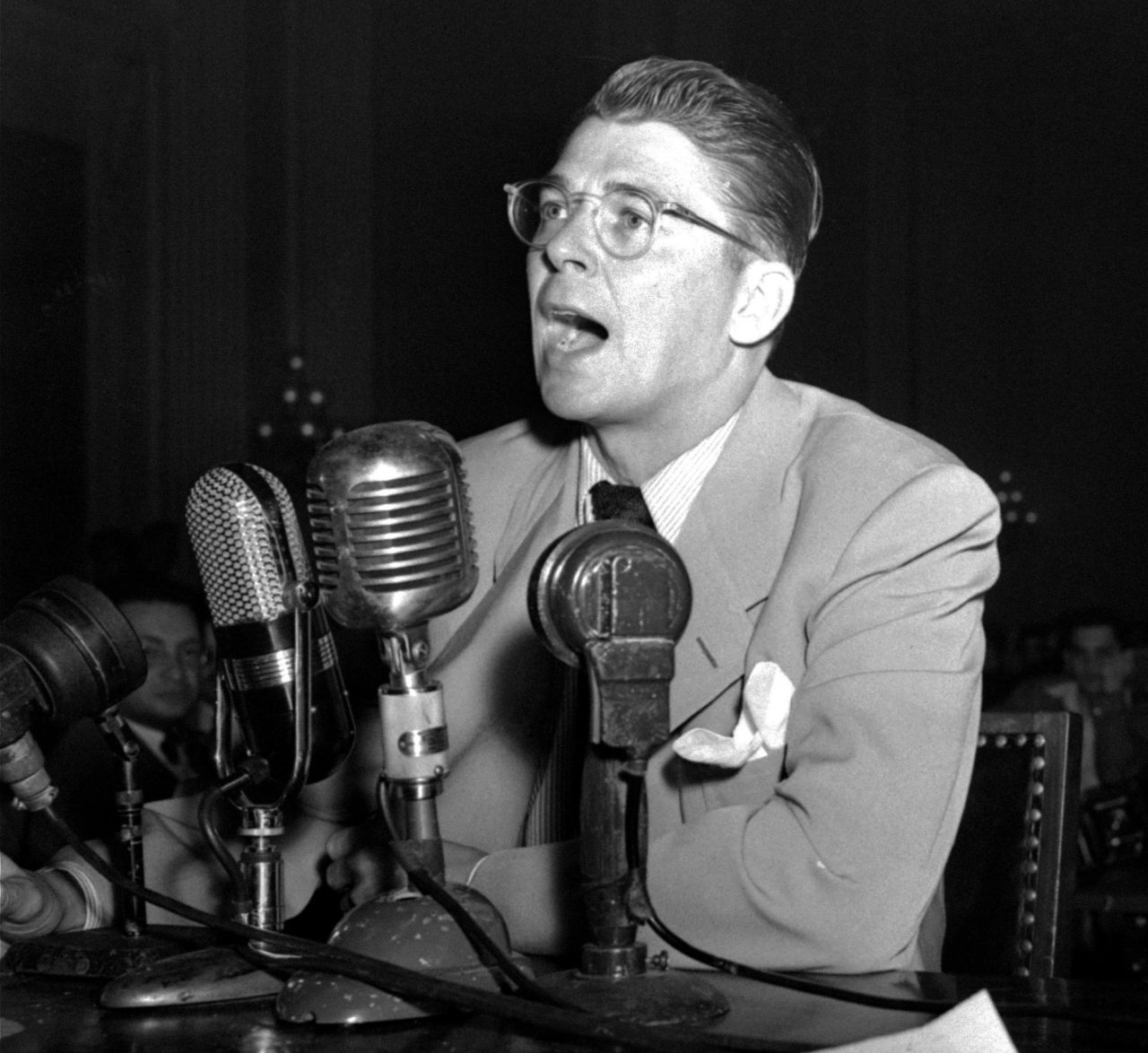
Ronald Reagan testifying before the House Committee on Un-American Activities in Washington, D.C., Oct. 23, 1947. (AP Photo)
Given that skill at needle-threading, it’s little wonder that Reagan was recruited for a leadership role in both the right-leaning Motion Picture Alliance for the Preservation of American Ideals and the left-leaning Hollywood Independent Citizens Committee of Arts, Sciences, and Professions.
Some might ask: Does this political ambidextrousness indicate that Reagan was some sort of word-weaseler? Even a conniver? Answer: No, not at all. It simply means that the Reagan of that day was just what he said he was—a patriot. He had, for example, volunteered for the Army Reserves back in 1937. To the Reagan of that era, having proudly served in the Army during World War Two, it made perfect sense to be a pro-New Deal anti-communist.
Indeed, Reagan’s broadly centrist sentiments can be seen in a post-war newspaper article: “America’s highest aim should be the cultivation of freedom of the individual, for therein lies the highest dignity of man.” And in fact, four decades later, in his 1990 autobiography, Reagan expressed the same sentiment once again:
Throughout my life, I guess there’s been one thing that’s troubled me more than any other: the abuse of people and the theft of their democratic rights, whether by a totalitarian government, an employer, or anyone else.
Still, beginning in the 50s, Reagan did move to the right—although it must be immediately noted that at the same time, the Democratic Party was moving to the left. Indeed, under the professorial and snobby leadership of two-time presidential candidate Adlai Stevenson, the Democrats began to lose their connection with the traditional working-class base of the party, even as they gained ground in university towns and other elite enclaves. Yet for his part, Reagan never lost his congenital connection to the working class, as subsequent history would prove.
As Reagan said any times, “I didn’t leave the Democratic Party, the Democratic Party left me!” It was more than a funny line—it was the truth. Thus we can see that Reagan was on the left when he thought that the right was mishandling the nation’s problems, and he was on the right when he concluded that the left was problematic. Yet in his own mind, Reagan was always consistent: he wanted what was best for the “forgotten man,” whom FDR had always spoken for as well.
So by the 60s, as the Democrats moved even further to the left, Reagan swung into outright opposition to what he saw as the egregious excesses of the post-FDR Democrats. Olsen writes:
Reagan’s interpretation of what the New Deal’s promises meant to 1960s America resonated with that coalition’s primary voting bloc, working-class whites. Upset over rising crime, rising taxes, and seeming disrespect for American virtues, many of these men and women increasingly backed Republicans for statewide and national office.
We can quickly observe that other older-style Democrats might have agreed with Reagan’s assessment. In fact, in 1989, Reagan looked back fondly at FDR’s anointed successor, Harry Truman, the 33rd president: “He wasn’t a tax-and-spend Democrat,” Reagan mused, even as he added, “I think he and I were in tune on a lot of things about government and I think if he had lived longer, he might have come over to the other side like I did.” (Indeed, we can note that today, Truman’s Missouri is one of the most Republican states in the country; Donald Trump carried its ten electoral votes last year by nearly 19 points.)
When Reagan sought the governorship of California in 1966, he ran on the platform of the “Creative Society,” his alternative to the Great Society. Olsen explains:
Reagan’s Creative Society envisioned government that in many respects was not too different from what FDR advocated in the New Deal. Government would continue to have an important role in providing education, welfare, and other services. Permanent aid would be limited to those who were in genuine need “through no fault of their own,” but most of the important—and costly—New Deal programs would remain substantially intact.
Olsen cannily notes that Reagan’s formulation, “through no fault of their own,” is a direct reference to a 1937 nationwide radio speech by FDR.
We can also observe that the FDR/RR distinction between the “no fault” poor and the “at fault” poor has been vaporized by today’s Democrats. In our time, no Democrat would dare to repeat FDR’s description of no-questions-asked welfare as “a narcotic, a subtle destroyer of the human spirit . . . inimical to the dictates of sound policy . . . in violation of the traditions of America.” So we can see: The Democrats left not only Reagan, but also Roosevelt.
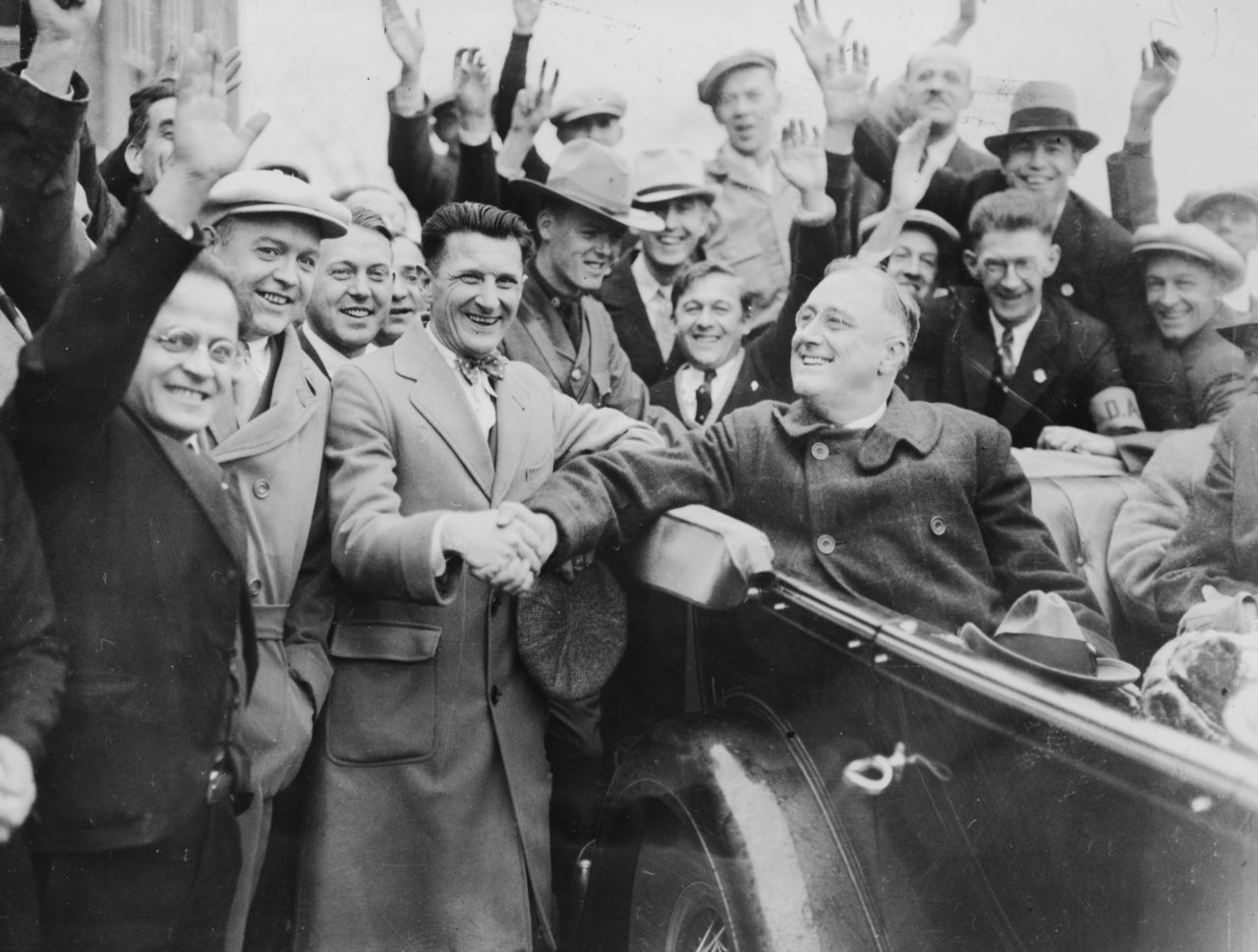
President Roosevelt shaking hands with supporters at the Veterans Hospital in Beacon, New York, November 7, 1932. (Photo by Edward H. Gooch/Keystone/Getty Images)
After two successful terms in Sacramento, Olsen continues, it was on the next challenge:
Reagan ran for president on essentially the same platform on which he ran for governor. Government would be trimmed but not repealed; taxes would be cut but not slashed; programs or actions that helped the “truly needy” or assisted average Americans to achieve their dreams would remain in place.
Once in the White House, Reagan still stayed true to the hero of his youth. In a ceremony on January 28, 1982, the 40th president celebrated the centennial of the birth of the 32nd president, describing him as “an American giant, a leader who shaped, inspired, and led our people through perilous times.” Continuing to laud his predecessor, Reagan added, “He meant many different things to many different people. He could reach out to men and women of diverse races and backgrounds and inspire them with new hope and new confidence in war and peace.”
That same day in his diary, Reagan was even more emphatic about what he believed:
The press is dying to paint me as trying to undo the New Deal. I remind them I voted for FDR 4 times. I’m trying to undo the “Great Society.” It was LBJ’s war on poverty that led to our present mess.
Indeed, in his eight years in the White House, Reagan cut spending, but not by much; he cut taxes, and yet he also reformed taxes—he actually raised the capital gains tax rate, so that rich investors wouldn’t pay a lower rate than working stiffs.
To be sure, the reality of Reaganomics disappointed some; one of the most vehement anti-Reagan books of that era came from his former budget director, David Stockman, who attacked his ex-boss from the perspective of a zealous righty.
Yet despite all the brickbats, Reagan left office as one of the most popular presidents in modern history, with two massive landslides under his belt. Why, there hadn’t been as big a winner in American presidential politics since . . . FDR.
Interestingly, many of the most vivid moments of the Reagan presidency were from events that celebrated the country as a whole, not any particular ideology.
For instance, there was his 1984 visit to Normandy Beach on the 40th anniversary of D-Day (“These are the boys of Pointe du Hoc”), and his 1986 speech on the occasion of the Challenger space-shuttle explosion (“Slipped the surly bonds of earth to touch the face of God”).
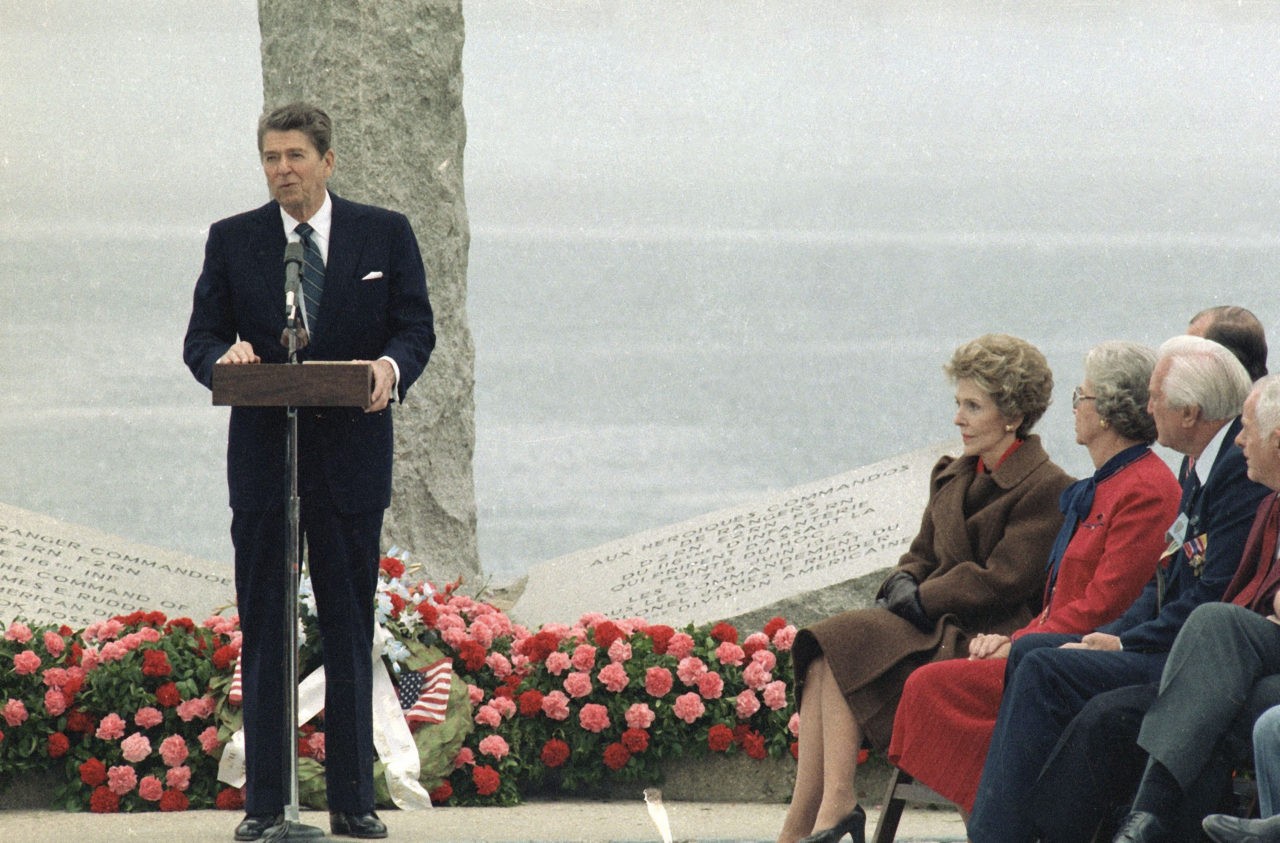
Reagan delivering his famous speech at the Pointe du Hoc Memorial in Normandy, France, June 6, 1984, for the 40th anniversary of D-Day (AP Photo)
Yes, Reagan is remembered as the Great Communicator, not because he pitched sectarian themes, but rather because he symbolized Morning in America. And if today’s Democrats feel a bit uncomfortable cheering for the USA, well, that’s another reason why Reagan ended up as a Republican.
Speaking of Republicans, Olsen offers some tart commentary on the current GOP—and he names names. Singling out Rand Paul and Paul Ryan among others, Olsen argues that they “fundamentally misunderstand Ronald Reagan’s legacy, because they remain unreconciled to the New Deal’s core principle: the primacy of human dignity.” There’s that phrase, human dignity, again: the phrase so often used by Reagan. As Olsen declares, echoing Reagan—and the vast majority of Americans—human dignity necessitates “government help for those who truly need it.”
Olsen adds that Reagan’s emphasis on individual dignity shielded him from “the classic Democratic charge that Republicans are the party of the rich and the boss.” By contrast, the Reagan man continues, “Today’s conservatives are sitting ducks for this charge.”
In other words, those who wish to follow in Reagan’s footsteps—footsteps that lead to massive presidential victories for the GOP of the sort we haven’t seen since the 1980s—should follow the actual wisdom of the man, not the myth. As Olsen explains, “Conservative election victories since 1980 have not been rejections of the New Deal’s promises but rather actions representative of the public’s wish for their fulfillment.”
So when Republicans, as they are wont to do, make their pilgrimage to the Reagan Library in California, they might gaze upon the words inscribed on Reagan’s tomb, which are a quote from the late president: “I know in my heart that man is good, that what is right will always eventually triumph, and there is purpose and worth to each and every life.”
If Republicans truly absorb those words, as Reagan intended them to be absorbed, then they, too, can be working class heroes. It’s a proven formula for political victory and policy triumph, because Reagan proved it.
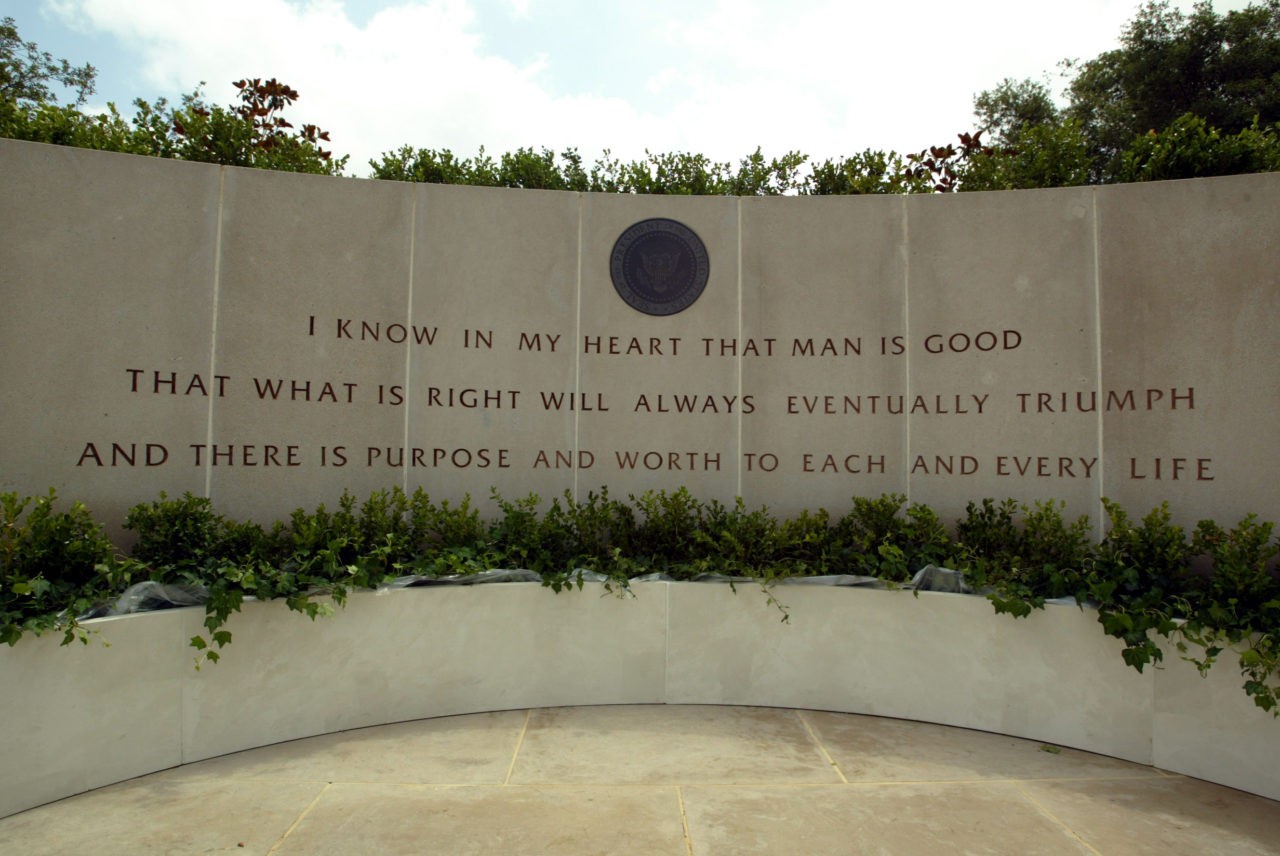
President Reagan’s tomb (AP Photo/Bryan Chan, Pool)
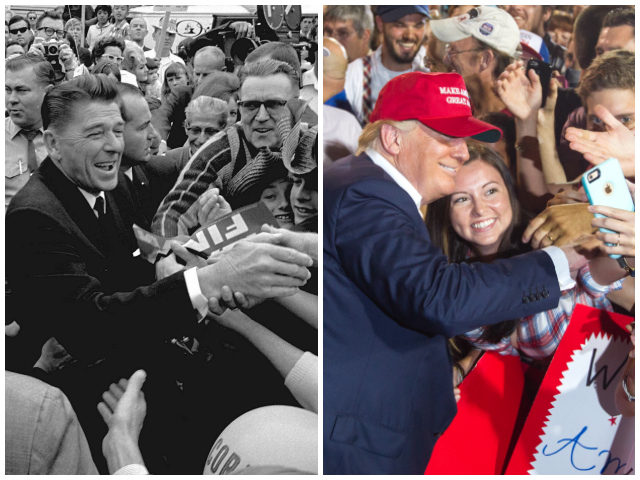
COMMENTS
Please let us know if you're having issues with commenting.